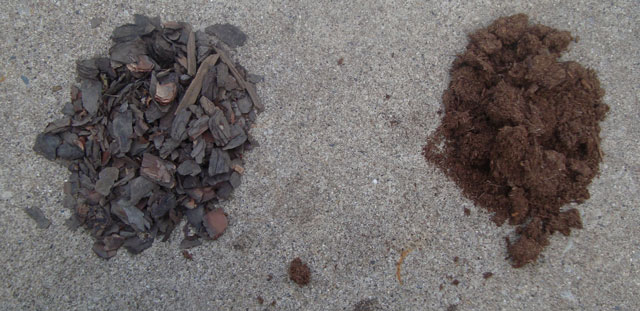I have often recommended Rhododendrons in four season gardens. These plants add winter interest as well as spring flowers. The main reason is that they add a different texture than the more commonly used evergreens such as pines, yews, and junipers.

Those plants are mostly fine to medium textured plants, while Rhododendrons can provide a coarser and bolder texture that can really stand out from the other evergreens. Some of these such as PJM Rhododendrons also turn a burgundy purple color in the winter that is attractive when offset by other evergreen shrubs or ground covers.
SOIL CONDITIONS FOR RHODODENDRONS IN FOUR SEASON GARDENS
These plants however grow best in areas with a different climate and different soil conditions than are common in my Chicago area location. Specifically, the limestone based soil of most the the Midwest will have a higher pH than most broadleaved evergreens thrive in. Therefore, some thought must be made as to how we can make the soil more favorable for these acid loving plants. Most broadleaved evergreens also require lots of oxygen in their root zone, so the soil must be well drained. If you have an acidic soil that drains well you can ignore this advice and just plant.

IMPROVING THE SOIL FOR RHODODENDRONS

So how do we do this? Well the standard prescription is to mix in peat moss with the soil as a means of acidifying the soil. This will enable the plants to absorb all the nutrients it needs from the soil. Besides lowering the soil pH with peat moss, you also want to increase the amount of oxygen in the soil. The clay dominated soil in my area has very little room for air. If you mix in shredded bark to the soil (along with peat moss), you add more air to the soil. To do this my recommendation is to add pine bark mulch to the soil. Pine bark is particularly good because it is thought to inhibit fungi that cause root rot.

OK, so how do you do this? If you have a rototiller, it’s pretty easy. Lay about three inches of peat moss on the soil and rototiller it into the soil. Next, lay down about another three inches of shredded pine bark on top of this area and rototiller that it. Your resulting soil will be higher than the surrounding area which will aid in drainage. You should do this to an area about as wide as the plant tag says the shrub will grow. That way, the soil will be ideal for the roots to grow into as the plant grows over the following years.
If you don’t have a rototiller, you can just dig out the soil in the smaller sections and mix it with about equal amounts of peat moss and shredded pine bark in a bucket.
A SECRET TO ADDING PEAT MOSS FOR THAT NOBODY TOLD YOU
Now, I am going to reveal the secret to this that NOBODY DOES. I don’t know any landscaper that does it. But if you don’t do this, you will stress your Rhododendrons unnecessarily. The reason is that when peat moss is dry it sheds water. Dry peat moss is almost impossible to get wet. Does that sound like an ideal thing to add to your soil? It’s not. All adding dry peat moss to your soil does is to rob your plants of the water they need. So what’s the secret?

Soak your peat moss in water for at least a day before you mix it into your soil. This will get it saturated so that it actually is holding water instead of repelling it. It’s also easy to do.
Buy it.
Put it in a garbage container.
Fill the container with water.
Mix it around to break up the Peat moss.
Wait a day or more and you’re ready to plant.
pamela delaney says
can I grow new guinea impatiens in the same planting area as rhododendron…same soil… one next to the other?
Jim says
I am not sure, but you can certainly try. Perhaps a bit more peat moss near the surface?